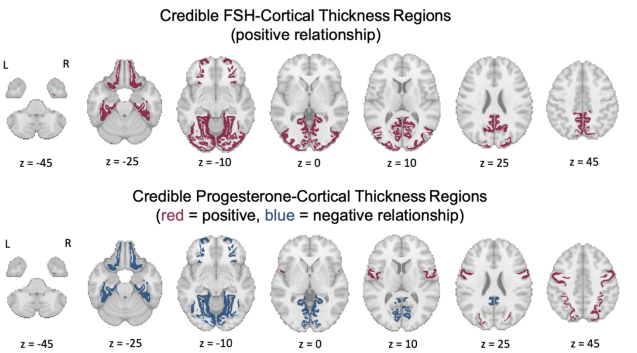
Menstrual cycle hormones drive whole-brain and regional structural changes
Elizabeth J. Rizor, et al. – UC Santa Barbara.
By studying 30 naturally cycling women at 3 points across their cycle, Rizor and colleagues identified links between menstrual cycle hormones and brain structure, both globally and in specific regions.
Post-COVID neuroinflammation linked to markers of vascular disease
Michael B. VanElzakker, et al. – Massachusetts General Hospital.
This cross-sectional study found negative correlations between [11C]PBR28 positron emission tomography (PET) neuroimaging, a marker for activated neuroglia, and serum biomarkers for vascular health on 12 individuals experiencing PASC and 43 controls.
Chimeric cortical organoids allow for probing human neuronal heterogeneity
Noelia Antón Bolaños, et al. – Harvard University.
By aggregating cells from different lines at the neural stem cell stage, Bolaños et al. were able to generate “Chimeroids” (chimeric organoids) that included all cortical cell types from each of 4 or 5 donors.
Dap12 knock-out lessens tau’s impact on glia and synapses – despite increasing tau?
Hao Chen, et al. – Weill Cornell Medicine.
Chen and colleagues studied transcriptomic changes to microglia and oligodendrocytes (OLs) induced by Dap12 KO in the Tau P301S mouse model, finding a broad shift away from disease-associated states in spite of increased levels of tau pathology.
Mice value information, even at the cost of reduced reward
Jennifer J. Bussell, et al. – Columbia University.
This study examined the role of the orbitofrontal cortex in mice for representing expected reward and information predictive of expected rewards.
Other Notable Preprints:
“A neural mechanism for learning from delayed postingestive feedback.” Christopher A. Zimmerman, et al. – Princeton University.
“Development of neural circuits for social motion perception in schooling fish.” David Zada, et al. – UC San Diego.
“Neural signatures of stress susceptibility and resilience in the amygdala-hippocampal network.” Frances Xia, et al. – UC San Francisco.
“Single-nucleus transcriptomics reveals disease- and pathology-specific signatures in α-synucleinopathies.” Gonzalo S. Nido, et al. – University of Bergen.




